- The amount of carbon dioxide (CO2) in the atmosphere continues to accelerate upwards despite global efforts
- The last two years had "unprecedented" increases
- Canadian CO2 extraction is playing an oversized role
The primary driver of global warming, disruptive climate changes and ocean acidification is the ever-increasing amount of carbon dioxide in our atmosphere.
Despite decades of global efforts towards climate policies, clean energy and efficiency, CO2 levels continue to rise and are actually accelerating upwards. For those of us hoping for signs of climate progress, this most critical and basic climate data is bitter news indeed. It shows humanity racing ever more rapidly into a full-blown crisis for both our climate and our oceans.
That's the story told by the newest CO2 data released by the United States National Oceanic and Atmospheric Administration (NOAA). Let's take a look....
Even the increases are increasing
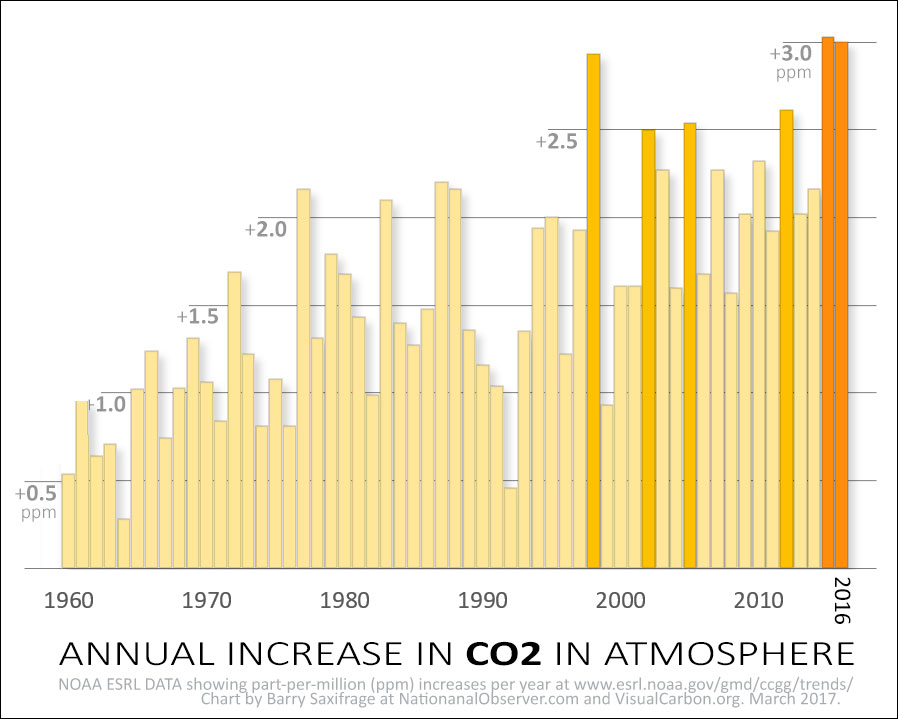
My first chart, on the far right, shows NOAA's CO2 data thru 2016.
Each vertical bar shows how much the level of CO2 in the atmosphere increased that year. You can see at a glance how the annual changes keep getting larger.
Indeed, the last two years (dark orange) saw CO2 rise by three parts-per-million (3 ppm) for the first time ever recorded.
And the relentless upwards march of CO2 is even more clear in the ten-year averages.
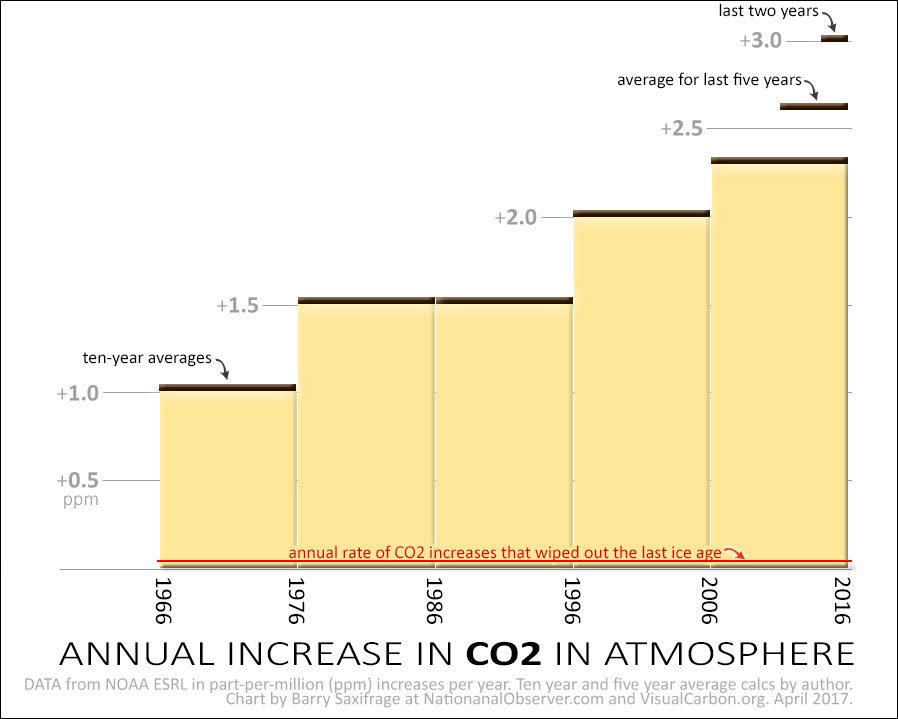
My second chart shows these ten-year average increases as yellow columns. Up, up, up.
"Unprecedented"
NOAA's press release highlighted the "unprecedented" CO2 rise in last two years.
The scientists also pointed out that 2016 "was a record fifth consecutive year that carbon dioxide (CO2) rose by 2 ppm or greater." Those last five years also broke a new record by exceeding +2.5 ppm per year for the first time.
I've included both the new five-year record and the new two-year record as black bars on the chart. All told, we've managed to pull off the triple crown of climate failure. The last ten years, five years and two years have all smashed records for CO2 increases.
If humanity is making climate progress, someone forgot to tell the atmosphere about it.
I thought we were making progress on CO2, what's going on?
Recently the climate press has been buzzing about a hopeful CO2 report from the International Energy Agency (IEA). The IEA estimates that fossil fuel CO2 didn't increase in either 2015 or 2016. Even better, they point out, this is the first time that has happened while the global economy expanded. I was curious how to reconcile this plateau in fossil fuel CO2 with the continued acceleration of atmospheric CO2. Here's what I found:
- Fossil fuel CO2 might be increasing. The IEA numbers might be wrong. They rely on nations to accurately report their fossil fuel use. Not all of them do, especially when it comes to burning their own coal supplies. In fact, the lack of a system to accurately verify national CO2 claims was a key issue in the Paris Climate Accord discussions. The worry is that as nations face increasing pressure and scrutiny around their CO2, the incentives to cook the books will increase. Incorrect accounting of just one percent globally could switch the storyline from "hopeful plateau" to "continuing acceleration". The IEA devotes two chapters of their "CO2 Emissions from Fuel Combustion" report to the various issues impacting data accuracy.
- Humans might be increasing CO2 emissions from other sectors. Roughly a quarter of the CO2 released by humans comes from non-energy sources not covered in the EIA numbers. These include land use changes, agriculture, deforestation, fugitive emissions, industrial processes, solvents and waste. We could be increasing CO2 from these.
- Climate change might be increasing CO2 emissions. Increases in wildfires, droughts, melting permafrost — as well as changes to plankton and oceans — can all cause sustained increases in CO2 emissions. And climate change is affecting all of these. Perhaps some of these changes are underway.
- The oceans and biosphere might be absorbing less of our CO2. Much of the CO2 humans release gets taken up by the oceans (ocean acidification) and the biosphere (increased plant growth). Some climate models predict these "CO2 sinks" will lose their ability to keep up. If that is starting to happen, then dumping the same amount of CO2 into the atmosphere will result in increasing amounts staying there.
Unfortunately we don't have good enough measurements to say what the mix of these factors is. However, what we can accurately measure is the CO2 level in our atmosphere. That's the CO2 number we have to stop from rising because it is what drives global warming, climate changes and ocean acidification. Sadly, it's also the CO2 number that shows no sign of slowing down yet.
Out burping the ice age
NOAA's press release also provided some perspective on how historically extreme our atmosphere's CO2 increases have been:
“... the rate of CO2 growth over the last decade is 100 to 200 times faster than what the Earth experienced during the transition from the last Ice Age. This is a real shock to the atmosphere.”
For context, during the last ice age all of Canada was buried beneath a massive northern ice cap. The ice was two miles thick over the Montreal region, and a mile thick over Vancouver. So much water was locked up in ice that global sea levels were 125 meters (410 feet) lower. We are talking a lot of ice and a radically different climate.
Recent research reveals that:
"... a giant 'burp' of carbon dioxide (CO2) from the North Pacific Ocean helped trigger the end of last ice age, around 17,000 years ago."
Just how big of a CO2 'burp' did it take to help heat the frigid global climate, eliminate the continent-spanning ice sheets and raise sea levels by hundreds of feet? Around 80 to 100 ppm — the same amount we've belched into our atmosphere just since 1960. We did it 100 times faster than that so-called "burp" and we are still accelerating the rate we pump it out.
I've added the ice-age-ending 'burp' rate as a red line on the chart above. Look for it way down at the bottom. Such incredible climate altering power from even small CO2 increases shows why we must reverse the buildup of CO2 in the atmosphere.
Adding it up: the rising level of CO2 in our atmosphere
So far we've only been looking at annual increases in the amount of carbon dioxide in the atmosphere. It's an important metric to evaluate whether we're making any progress against climate pollution. But what actually drives the greenhouse effect is the total amount that has accumulated in our atmosphere over time. So let's take a look at that.
Here's my next chart showing atmospheric carbon dioxide as a solid blue line. Just for interest, I've also included a series of dotted lines showing how quickly CO2 was increasing in each of the last few decades. I've extended each of those out to 2030 so you can see at a glance how the CO2 curve keeps bending relentlessly upwards, decade after decade.
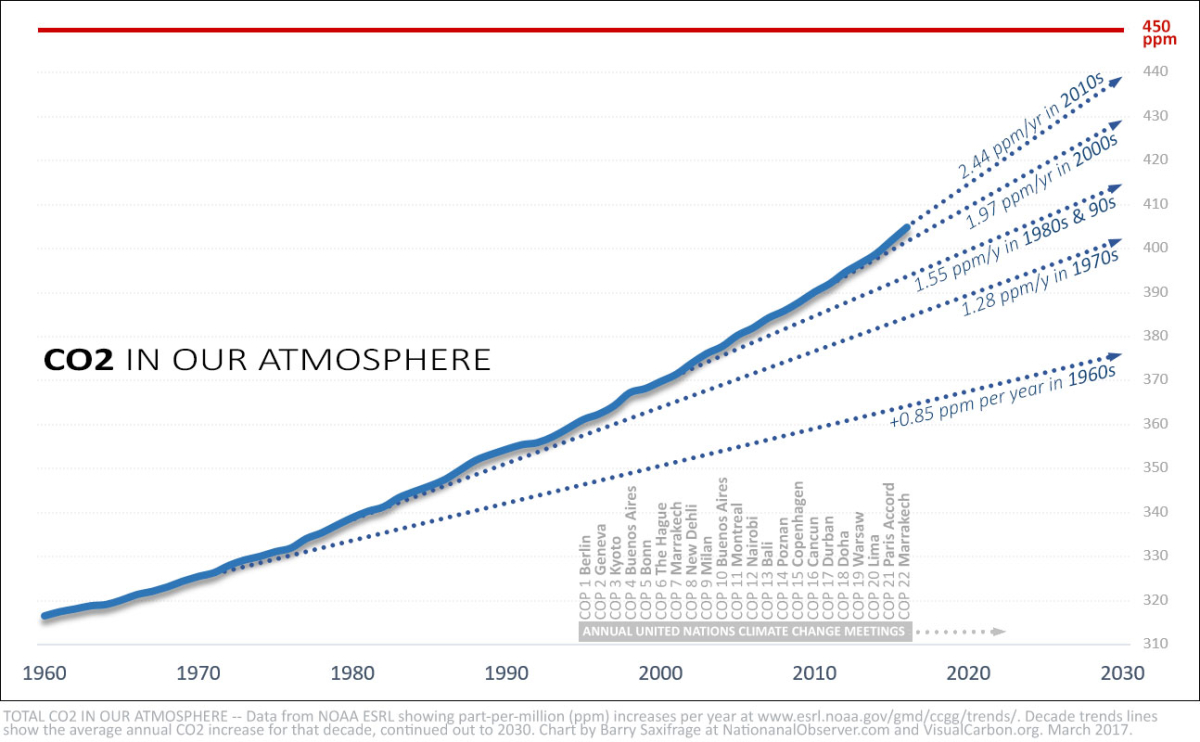
Accelerating towards the 450 ppm 'guardrail'
Every major nation in the world has agreed that climate change must be limited to a maximum of +2oC in global warming. Beyond that point we risk destabilizing droughts, floods, mega-storms, heat waves, food shortages, climate extremes and irreversible tipping points. The best climate science says that staying below +2oC means we can't exceed 450 ppm of CO2.
At the top of the chart I've highlighted this critical climate 'guardrail' of 450 ppm as a red line.
Notice how much faster we are approaching that danger line as the decades go by. Back in 1970, it seemed we had more than a century and a half to get a grip on climate pollution because CO2 was increasing much more slowly. But at our current rate we will blow through that guardrail in just 18 years. And, as we've seen, our "current rate" keeps accelerating.
Our foot-dragging at reducing climate pollution has left us in a dangerous situation with little time left to act. We've spent decades accelerating CO2 emissions to unprecedented extremes. We've blown our chance to deal gracefully with the climate and ocean crisis.
Global efforts so far
Beginning in 1995, the world's nations have gathered every year to address the climate crisis. I've included all 22 of these annual meetings of the United Nations Conference of Parties (COP) on the chart above. Despite these decades of negotiations, plans, protocols and accords, CO2 is now increasing 60 per cent faster than when they first met.
Instead of slowing the rise of CO2, we've accelerated it.
What would Plan B for 2C look like?
Recently, two of the world's premier energy agencies -- International Energy Agency (IEA) and the International Renewable Energy Agency (IRENA) -- produced a joint report that tries to answer that question. Here's the blunt summary:
"Limiting the global mean temperature rise to below 2°C with a probability of 66% would require an energy transition of exceptional scope, depth and speed. Energy-related CO2 emissions would need to peak before 2020 and fall by more than 70% from today’s levels by 2050 … An ambitious set of policy measures, including the rapid phase out of fossil fuel subsidies, CO2 prices rising to unprecedented levels, extensive energy market reforms, and stringent low-carbon and energy efficiency mandates would be needed to achieve this transition. Such policies would need to be introduced immediately and comprehensively across all countries … with CO2 prices reaching up to US dollars (USD) 190 per tonne of CO2."
And here is their key chart showing annual energy-related CO2 emissions. Note the 50 percent surge since 1990 ... and the need to reverse it by 2030.
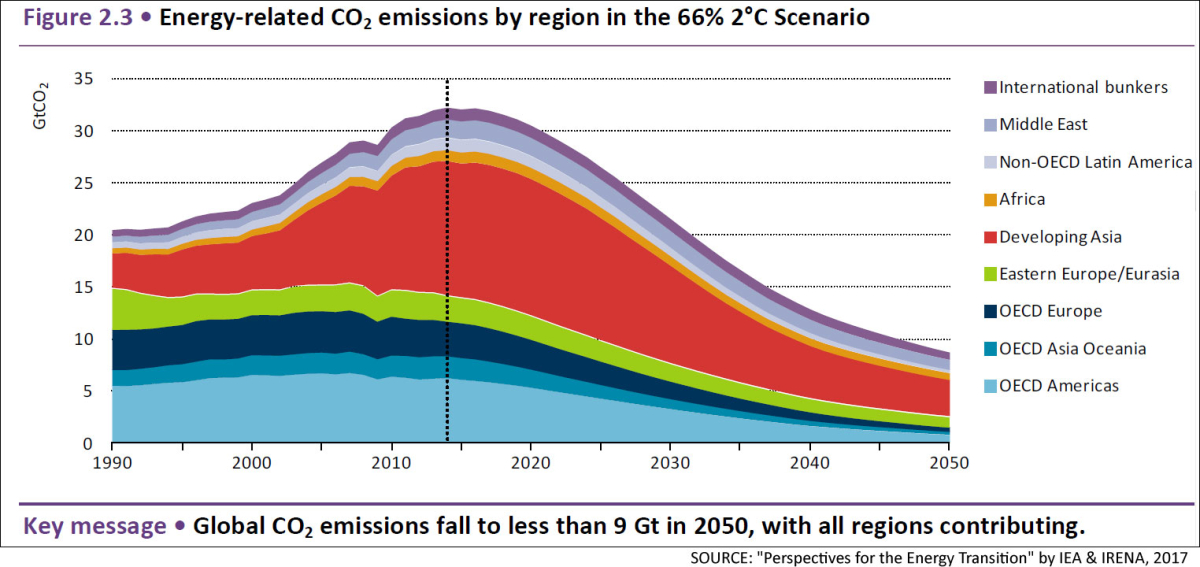
This report is just the latest to show that the path to a safe climate future requires rapid reductions in how much CO2 we pull out of the ground each year. Canada, however, is planning to do the very opposite.
Canada's oversized role
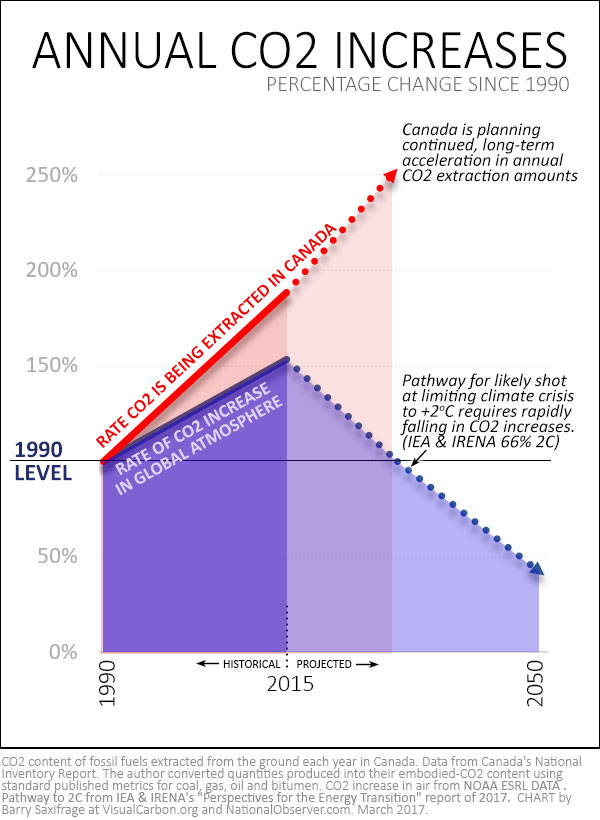
My next chart, on the right, illustrates the super-sized role Canada is playing in the accelerating climate crisis.
BLUE: CO2 INTO THE ATMOSPHERE
The solid blue line on the chart shows annual CO2 increases so far. As discussed above, these have shot up by 50 per cent since 1990. The blue line peaks and falls rapidly illustrating the pathway to a safe future (dotted). This represents the IEA/IRENA path to 2 degrees Celsius. Lets now compare those to what Canada is doing.
RED: CO2 EXTRACTED IN CANADA
The solid red line, bolting upwards, shows the percentage change in Canada's annual extraction of fossil fuel CO2. The amount of CO2 pulled out of Canadian soil through oil and gas extraction every year has doubled since 1990.
As a result, Canadians have become one of the world's leading extractors of fossil fuel CO2.
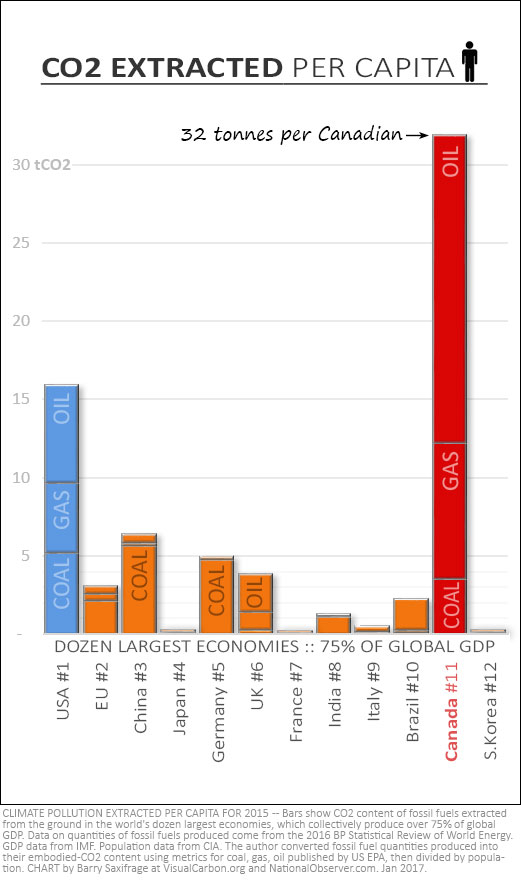
To illustrate, here's a chart from my recent article detailing this rise. The chart shows CO2 extracted per capita for the world's dozen largest economies. These economies combined produce 75 per cent of global GDP.
Back in 1990 we extracted CO2 at levels similar to the Americans. Not anymore!
With humanity accelerating towards a full-blown climate crisis, is Canada willing to reduce CO2 extraction as needed?
No.
Just the opposite.
As the upward dotted red line in the chart of Annual CO2 Increases shows, Canada is planning absolutely massive increases. How big?
A new report from Oil Change International (OCI), "Climate on the Line", surveyed global projections and concluded:
"over the next twenty years, the industry is set to expand oil production by more in Canada than in any other country. If it continues on this course, Canada could become one of the world’s largest extractors of the new carbon that would drive the atmosphere over the edge."
Meanwhile, Prime Minister Justin Trudeau, has been using the power of his office and his powers of persuasion to push Canada's CO2-extraction to ever higher levels. He's approved several new pipelines for oil and fracked gas to carry it all.
In addition, Trudeau was granted his wish to see the Keystone XL pipeline built when U.S. President Donald Trump agreed to expedite construction of TransCanada's mega-pipeline that had been denied because of its climate impact.
Can the judiciary save us?
As the atmospheric CO2 data clearly shows, governments have failed to stop CO2 from accelerating towards the 450 ppm "guardrail" and oil production data shows us hurtling "over the edge."
If there is a force capable of stopping the rise in CO2 in time, perhaps it is the judiciary. In many nations, the judiciary has the power to force governments to act.
Indeed, climate lawsuits, on behalf of the younger generation, are starting to win legal victories around the world.
One of the most-watched is a constitutional climate change lawsuit originally filed by a group of American youth against the Obama administration. They claim the government failed to protect their "constitutional rights to life, liberty, and property, as well as failed to protect essential public trust resources." The youth argue they are being forced into a situation that will require them to deal with increasingly destabilizing climate impacts, while simultaneously finding and funding some way to remove billions of tonnes of CO2 from the air and oceans. It is a scenario that, "... may become unmanageable. Simply put, the burden placed on young people and future generations may become too heavy to bear."
These youth recently won a major legal victory when they were granted the right to take the U.S. government to trial.
As National Geographic reports in an excellent article about the case, the youth then won again when the Obama administration, in one of their last weeks in power, filed a brief conceding all the basic climate facts raised in the case.
But the Obama administration still pushed for dismissal arguing that the elected government, not the judiciary, is the proper forum to address climate change.
However, that argument seems increasingly threadbare as the fiercely-hostile-to-climate-action Trump administration takes control of the executive branch. Trump's budget director Mick Mulvaney stated plainly:
"Regarding the question as to climate change I think the President was fairly straightforward. We're not spending money on that any more."
It doesn't get much clearer than that, eh?
In a series of executive orders, President Trump has already repealed many of the United States' major climate initiatives. And more are on the chopping block.
The combination of government admitting to the facts of the crisis, while stating plainly that they don't plan to do anything to stop it, seems ripe for judicial intervention.
In the meantime, governments, societies and businesses dither while CO2 levels in our atmosphere continue their relentless climb.

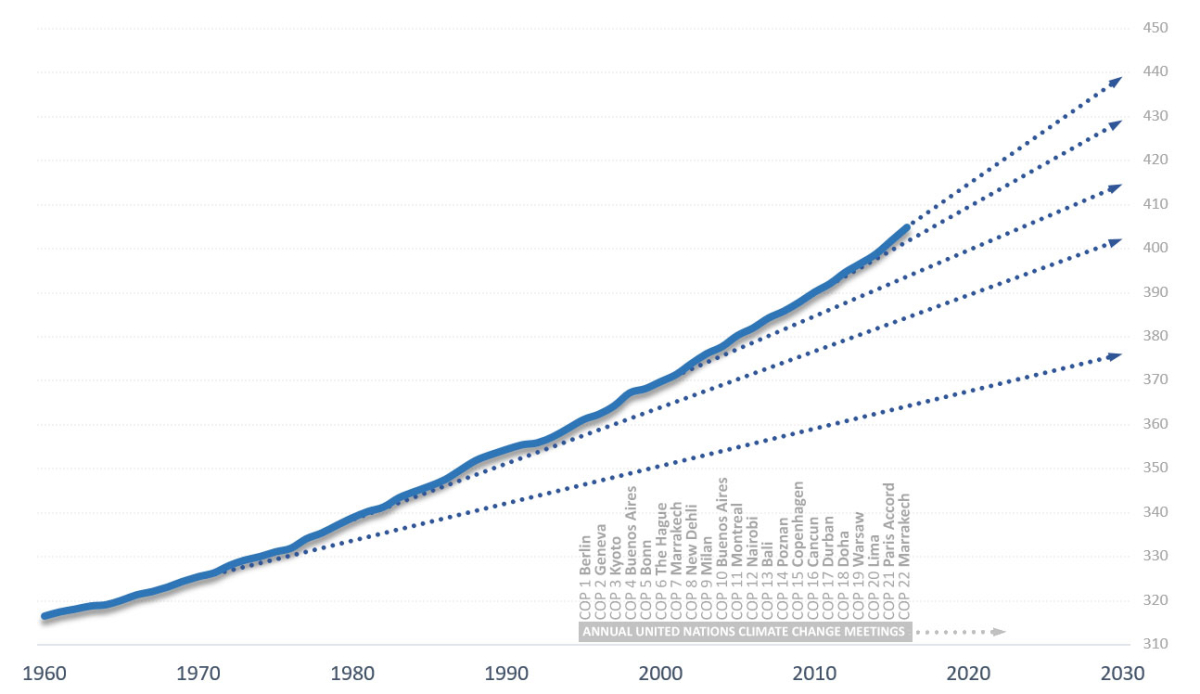




Comments
Thank you Barry for this well-researched and clearly-presented update on the climate crisis. The trends, as the data in your graphs show, are unmistakable and horrific. It seems most governments have stopped acting in our common best interests; they're actions appear to be dictated by the financial clout of certain corporations with much more money than wisdom.
Can the judiciary save us? Good question!
Here is a guy who diligently, unrelentingly keeps going. The one intellectual scientist who keeps on it, keeps trying to warn us, tell us what is happening. While our PM stands in front of the camera and the audience, making profound defenses and excuses, and pseudo-arguments that you can keep ramping up the infrastructure to dig and pump and pipeline the stuff that is killing the planet, and then say that black is white, down is up, sour is sweet, that we can control the CO2 while all the time increasing its poisoning density. Are there any brains in our marvelous oh Canada that dare to stand against this idiocy besides this one thinking, lonely crusader? Wake up oh wondrously stupid Canada!!!
Canada doesn't include GHG emissions from the LULUCF sector in its biennial report to the United Nations Framework Convention on Climate Change (UNFCCC) despite the fact that the UNFCCC has recognized the important role of the "Land Use, Land-Use Change and Forestry" sector in addressing climate change.
The LULUCF sector involves GHG fluxes between the atmosphere and Canada's managed lands, as well associated with lan-use change. LULUCF is a particularly important sector for Canada given that 10% of the world's forests (and 24% of the world's intact forests) are in Canada and our managed forest covers 229 million hectares, more than the managed forest in the entire European Union.
In a spring 2012 submission to the UNFCCC, Canada, along with a number of other countries, stated its intent to include the LULUCF sector in its accounting of GHG emissions towards its 2020 target, noting that emissions and related removals resulting from "natural disturbances" would be "excluded" from the accounting.
(source: Environment Canada-Climate Change-Canada's Emissions, "The Land Use, Land-Use Change and Forestry Sector")
GHG emissions from "natural disturbances" include emissions resulting from forest fires and other disturbances like insect infestations such as the mountain pine beetle. Forest fires burn on average 2 million hectares each year in Canada, twice the average area burned in the early 1970's.
During the 1990-2011 period, annual emissions directly from wildfire ranged from a high of 264 million tonnes (Mt) of carbon dioxide equivalent (CO2 eq) in 1995 to a low of 11 Mt in 2000. In 2011, the managed forests acted as an overall "net carbon source", releasing 84 Mt (CO2 eq) to the atmosphere. In 2014, this net flux amounted to emissions of 72 Mt, which, if included, would increase the total Canadian GHG emissions by about 9.8% . In 2014, a total of 5,126 forest fires burned about 4.6 million ha (3.97 ha in 2015). While the number of fires was lower than the 10-year average, the area burned was about twice the 10-year average. The Northwest Territories, with more than 3 million ha burned, was over 10 times its 10-year average. According to Canada's First Biennial Report 2014 to the UNFCCC: " Between 1948 and 2012, the annual average surface air temperature over Canada's landmass warmed by 1.7ºC, approximately twice the global average...Northern Canada (north of 60º latitude) has warmed at a rate approximately 2.5 times the global average since the late 1940's." Scientists at the NRC's Canadian Forest Service predict that the forest area annually burned in Canada is likely to double by the end of the century as a result of warmer temperature due to climate change.
(source: Natural Resources Canada, 2013-12-04: "Peatlands Fires and Carbon Emissions")
(source: Natural Resources Canada: "The State of Canada's Forests 2015")
Despite the fact that GHG emissions from the LULUCF sector can be more and more accurately estimated, the Trudeau government did not include GHG emissions from the LULUCF sector in its 2016 report to the UNFCCC, but indicated in foot-note that in 2013, the LULUCF sector represented a "net removal of 15 Mt" (how convenient...).